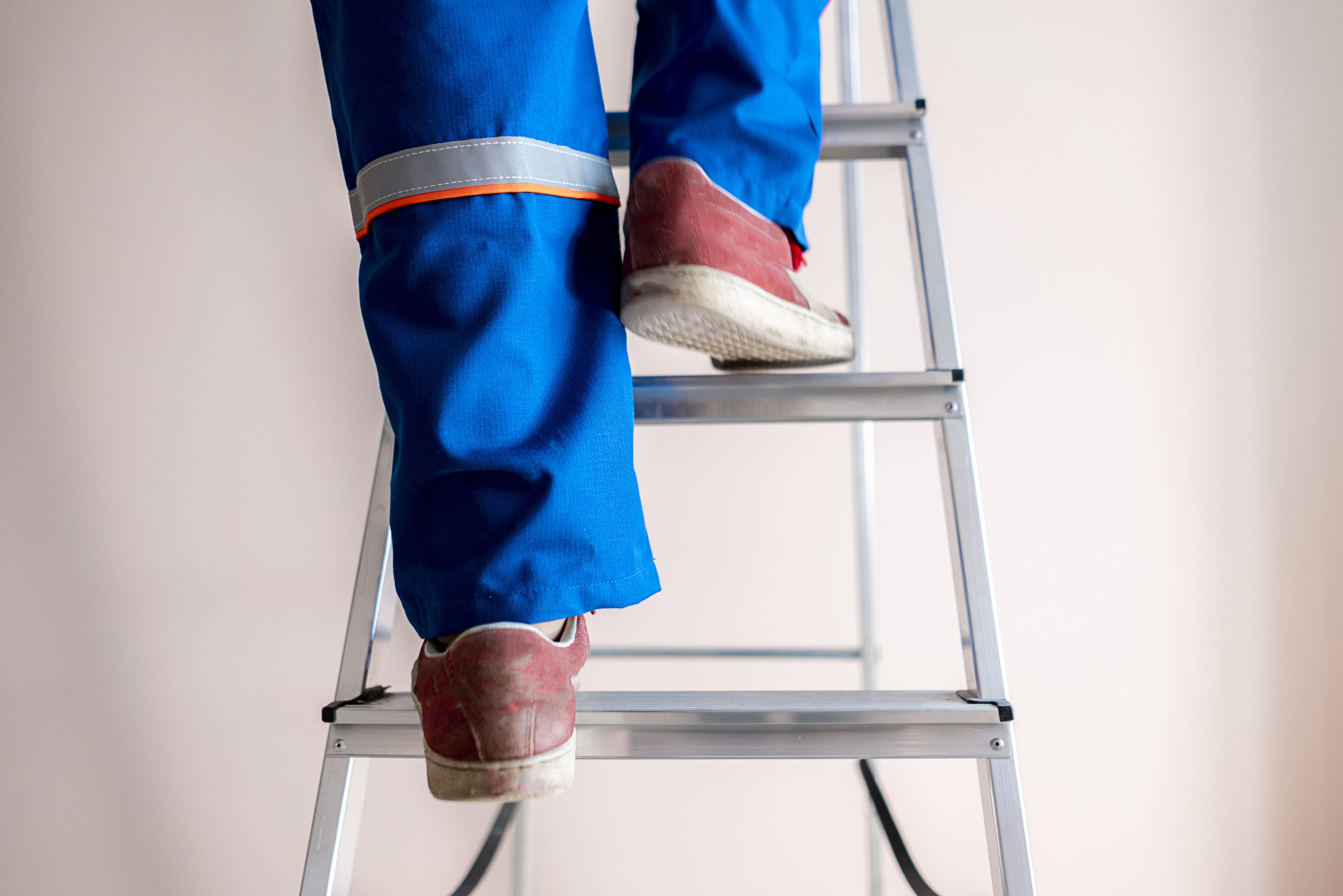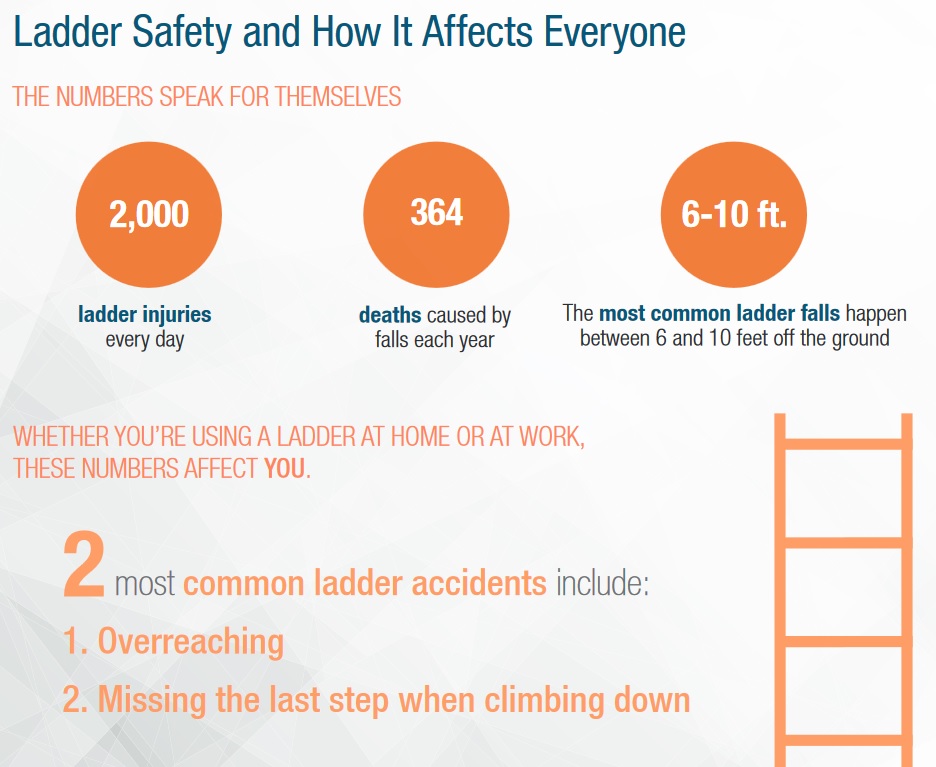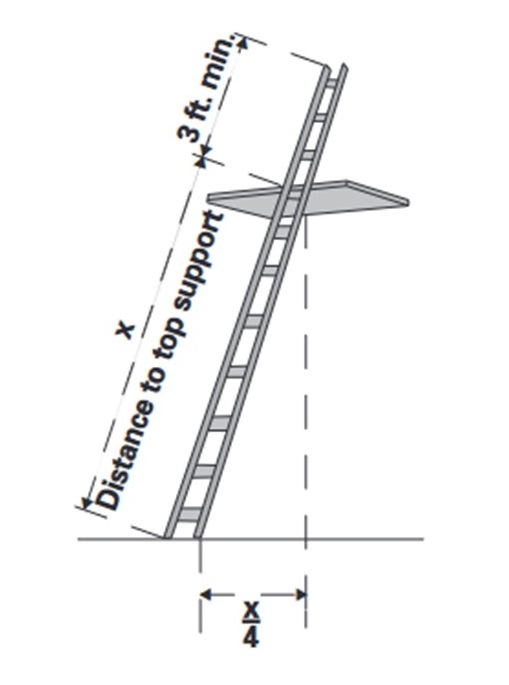Stay on Top of Ladder Safety!
 Ladders are a commonly used tool in both the workplace and the home. Unfortunately, when not used properly, they can also be a source of danger with injuries ranging from the non-serious bruised ego or minor ankle sprains to more significant injuries such as serious sprains/strains, broken arms, broken vertebrae and in severe cases, death. According to the American Ladder Institute, “on average, work-related ladder falls result in one death and more than 180 nonfatal injuries every two days in America”.
Ladders are a commonly used tool in both the workplace and the home. Unfortunately, when not used properly, they can also be a source of danger with injuries ranging from the non-serious bruised ego or minor ankle sprains to more significant injuries such as serious sprains/strains, broken arms, broken vertebrae and in severe cases, death. According to the American Ladder Institute, “on average, work-related ladder falls result in one death and more than 180 nonfatal injuries every two days in America”.
And it’s not just for those who use longer ladders like you see in construction. Even the small 2-3 step ladders commonly found in homes can be a source of injury. From window washing and home repairs to changing light bulbs and decorating a space, they are used for much more than simply reaching the top shelf. This infographic from the University of Kansas offers striking statistics and things to remember, in support of ladder safety:

For more ways you can stay on top of ladder safety, consider these 5 Basic Rules of Ladder Safety from the Environmental Health Safety & Risk Management of New Mexico State University:
RULE 1: SELECT THE RIGHT LADDER FOR THE JOB
With so many types of ladders available, it is important to select one that is appropriate for your intended usage. Things to consider:
- What load capacity will you need? A medium-duty ladder with a load capacity of 225 pounds may be great for painting, but if you will be doing heavier work, or if you yourself are heavier, you may need more of an industrial, heavy-duty ladder.
- Is the ladder long enough? You should be able to complete your work without using the top 3 feet of the ladder.
- Are there sources of electrical current in the area you will be working? If so, avoid an aluminum ladder that can conduct electricity and put you at risk of being shocked.
- Look for the American National Standards Institute (ANSI) label to ensure the ladder meets basic standards regarding the safe construction, design, testing, care and use of various types of ladders.
RULE 2: INSPECT THE LADDER BEFORE YOU BEFORE YOU USE IT
No matter how great a tool is when new, if it is damaged, it may not be safe to use. It is important to inspect a ladder before each usage.
Look for “loose or damaged rungs, steps, rails or braces. Also check for loose screws, bolts, hinges and other hardware.” If any defect or damage is found, do not use the ladder until it has been appropriately repaired or replaced. The ladder rungs, and hand holds, as well as your shoes, should be clean of any substances that could make them slippery.
RULE 3: SET UP THE LADDER WITH CARE
Location, location, location! As with any tool, a ladder that is not used correctly can open the possibility for danger and injury.
If there is a door close by, ensure it is locked or blocked to prevent it opening into the ladder or a person walking into the ladder. A ladder should be placed on a solid, level surface that is clear of clutter. Stepladders should be fully opened and locked to prevent them folding up while in use. Straight ladders should be placed at a 4-to-1 ratio, meaning for every 4 feet of height, the base should be 1 foot away from the wall (an 8-foot-tall ladder would then be placed at least 2 feet from the wall, etc).
Additionally, if you will be climbing from the ladder to another surface such as a platform or roof, the ladder should be tall enough to extend a minimum of 3 feet above the edge and be tied off at the top before you begin to transfer from the ladder to the surface. See the below image from the OSHA Portable Ladder Safety Quick Card.
According to the CDC, “In approximately 40% of cases, the leading cause of ladder-related injuries is a ladder sliding out at the base due to an incorrect setup angle.” That’s a lot of injuries that can be easily prevented simply by setting up the ladder correctly!
If you will be using a ladder outside, ensure that the weather is safe for you to do so. You don’t want to be on an aluminum ladder in a thunderstorm or have your ladder blow over leaving you stranded on the roof!
RULE 4: CLIMB AND DESCEND LADDERS CAUTIOUSLY
Remain facing the ladder when climbing or descending a ladder – do not use it like stairs. Maintain a 3-point contact (two hands and a foot, or two feet and a hand) on the ladder when climbing or working. Tools you will need should be carried on a tool belt, passed up to you by an assistant, or raised and lowered with a hand/tow line. This enables you to use both hands freely when climbing.
RULE 5: USE COMMON SENSE WHEN WORKING ON A LADDER
We’ve all seen the comedy antics of leaning ladders, but since you probably don’t have a special effects team or stunt double, it’s best to use common sense in working on a ladder. Always hold on and never reach too far to either side (a good rule of thumb is to not allow the mid-line of your body to extend past the sides of the ladder. Don’t use the top 3 steps of a ladder unless it’s specifically made for that. Never try to move the ladder while a person or equipment is on the ladder.
Once you’ve checked the ladder, it’s time to check yourself! If you are having issues with your balance, feeling faint, have weakness in arms or legs, are taking a medication that makes you light-headed, or have any other questions or concerns about your ability to climb a ladder safely…Avoid climbing on a ladder!
Ladders are a great tool for a wide range of tasks in both the home and workplace. While homeowners don’t typically have access to extensive ladder safety training, these few steps can go a long way to preventing injuries and keep you ready to climb again.
If you would like additional information on ladder safety, here are some resources you may find helpful:
- American Ladder Institute has several videos demonstrating ladder safety concepts and even has a ladder training program.
- OSHA has a quick reference card you can print out to keep handy with your ladder.
- The National Institute for Occupational Safety and Health (NIOSH) has developed a NIOSH Ladder Safety phone app that “has an angle of inclination indicator which uses visual and audible signals making it easier for workers and other users to set an extension ladder at the proper angle of 75.5 degrees.”
As with any physical activity, your physical health will be a significant determining factor as to your overall safety during the task. Climbing and working while on a ladder require not only basic strength, but also balance and can be affected by cardiovascular health. Your doctor of chiropractic can help you maintain overall wellness to help you stay healthy and ready to do whatever task is needed. Additionally, they can refer you to other health care providers if your situation requires care from another specialty.
If you have questions about strength and balance, discuss them with your doctor of chiropractic at your next visit.
RESOURCES:
Ladder Safety Resources https://www.americanladderinstitute.org/page/LadderResources accessed 3/31/22
Basic Rules of Ladder Safety New Mexico State University Environmental Health Safety & Risk Management https://safety.nmsu.edu/occupational-safety/industrial-safety/fall-protection/ladder-safety/#:~:text=Always%20face%20the%20ladder%20and,them%20with%20a%20hand%20line.&text=Always%20hold%20on%20with%20one,side%20or%20to%20the%20rear.
University of Kansas, Environment, Health and Safety NATIONAL LADDER SAFETY MONTH, WEEK 4: LADDER SAFETY AT HOME Monday, March 19, 2018 https://ehs.ku.edu/national-ladder-safety-month-week-4-ladder-safety-home accessed 3/31/22
Portable Ladder Safety OSHA Quick Card https://www.osha.gov/sites/default/files/publications/portable_ladder_qc.pdf accessed 3/31/22
Falls from ladders are preventable: Make ladder safety a priority https://www.cdc.gov/niosh/newsroom/feature/ladder-safety.html accessed 3/31/22